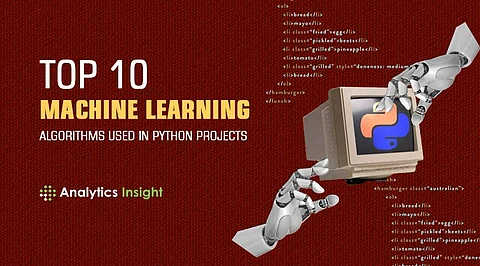
- Insights
- Cryptocurrencies
- Stocks
- White Papers
- Industry
- Geography
- Insights
- Cryptocurrencies
- Stocks
- White Papers
- Industry
- Geography


Machine Learning is the process of employing algorithms to help computer systems progressively improve their performance for some specific tasks. Python is one of the most amazing programming languages to fabricate savvy frameworks or machines due to enjoying different benefits which advance ML. ML algorithms shape the framework and lay out the foundations behind how the machine or system will function. Python is capable of doing several machine learning tasks. In this article, we'll talk about 10 of the most used machine learning algorithms in Python projects.
Linear regression: Linear regression is one of the supervised Machine learning algorithms in Python that observes continuous features and predicts an outcome. It establishes a relationship between dependent and independent variables by fitting the best line. This fundamentally means that it shows how the dependent variable is affected by the value of the independent variables.
Decision Trees: A decision tree is built by repeatedly asking questions about the partition data. A decision tree falls under supervised Machine Learning Algorithms in Python and comes of use for both classification and regression- although mostly for classification. It is used mainly for classification rather than regression.
Naive Bayes: Naive Bayes is a supervised machine learning algorithm used for classification tasks. A Naive Bayes classifier will assume that a feature in a class is unrelated to any other. This algorithm offers a model which works well with massive datasets.
K-nearest Neighbors or KNN: This is a supervised ML algorithm that considers different centroids and uses a usually Euclidean function to compare distance. KNN is used for both regression and classification tasks.
Discreet Hopfield Network: It makes a fake neural organization that stores data and can review this data from fractional input. This algorithm offers machines a recurring behavior that can be termed auto-associative.
Logistic regression: This algorithm is used to predict the probability of an event's occurrence by fitting that data into a logistic curve or logistic function. It is one of the most popular supervised ML algorithms, which uses a logistic function to determine the output as either 1 or 0.
Random Forest: A random forest is an ensemble of decision trees. Random Forest classifies objects based on attributes, and each decision tree is given a class. This algorithm then, at that point, picks the class which reports the largest number of trees.
Support Vector Machines: This is one of the most important machine learning algorithms in Python which is mainly used for classification but can also be used for regression tasks. It plots a line that divides different categories of your data.
Backpropagation: This is a supervised learning algorithm that is used for classification and regression. Backpropagation observes the base upsides of blunder capacities through inclination plummet or the delta rule method. This is how the calculation finds the necessary loads that will limit or error functions.
XGBoost: It is a gradient boosting algorithm that is used for various functions such as regression, ranking, and classification. This contains the tree learning algorithm and the direct model both, which permits XGBoost to foresee occasions with high accuracy.
